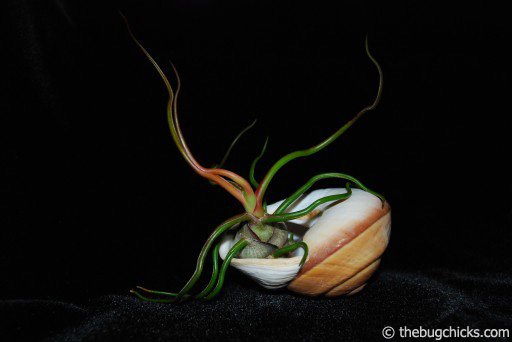Make Mini-Vivariums for a Touch of Green
A glass dish, some sand, pebbles from a long ago beach excursion and a Tillandisa sp. plant and we have a beautiful bit of the outdoors…inside!
We've got the end of winter blahs. You know the ones. When the weather can't decide if it's winter or spring and it's a bit past the snow but the green hasn't managed to arrive yet. So, this past week, we made some mini-vivariums and bought some special air plants for our office. Now, we know that we’re The Bug Chicks, but a) we love all things green and nature-y, and b) plants and insects go hand-in-hand! And let’s face it – after a few months of having no leaves on the trees, a little plant life definitely goes a long way.
An air plant in a giant snail shell becomes a work of art! Or a green sea creature!
Our air plants are Tillandsia spp. in the family Bromeliaceae (the same family as pineapples!). Air plants are epiphytes; this means they grow on other plants, usually trees. However, these plants are not parasitic and don't steal the nutrients from the plant upon which they grow, rather, they absorb nutrients and moisture from the air through their leaves. The roots at the base are there to serve as anchors. Bromeliads aren't the only plants that can be epiphytic. In fact many types of orchids, cacti, ferns and mosses are epiphytes!
These plants are great indoors, because they require very little care. Just submerge them in water every other week and spritz daily and they are good to go! In the wild, all kinds of insects and spiders live in them. In large epiphytes, tarantulas can be found hiding near the inner leaves! The tiny pools of water that collect at the base of the spiky leaves of bromeliads are microhabitats of insects like mosquito larvae, flies, and beetles. In fact, some species of helicopter damselflies, the largest damselflies in the world, use these pools as their specific breeding grounds. The aquatic naiads of the damselflies are the top predators in these tiny plant pools.
This beautiful handcarved dish comes from Bougainville Island and is a perfect fit for this spiky epiphyte.
We found our air plants at a local nursery, but even though its winter, there is some greenery to be found outside. We were totally inspired by the gorgeous green moss that grows so well here in the Pacific Northwest, so while we were hunting for dishes for our air plants we decided to buy some glass candy dishes to keep some moss inside! Here’s what we did:
1) Bought some glass candy dishes from Goodwill. $3 – score!
2) Lined the bottom of the dishes with gravel (it helps with drainage).
3) Went into the backyard and carefully scraped moss from the base of a tree.
4) Placed the moss over the pebbles.
5) Mist every day with water.
Serve up a little moss in an antique glass candy dish!
Moss is another plant that makes great habitat for tiny arthropods. Springtails (tiny primitive hexapods that are related to insects) are found in abundance in moss. If you create your own moss vivarium (mossarium?), you’ll probably be able to see them bouncing around as you spray the moss with water. They are detritivores, meaning they eat decaying matter in leaf litter, soil, moss and lichens. To learn more about these cool animals, check out the post where wrote about seeing them under a Scanning Electron Microscope!
Just mist the moss once a day to keep it green and healthy!
These little open vivariums are totally easy to care for and make for a great evening or weekend project. Plus, they make great habitats for studying tiny animals like springtails. Whether you use plants from your backyard or buy them from a nursery, this is an inexpensive, fun way to add a bit of green to your indoor spaces. Enjoy!





